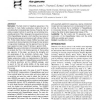Free Online Productivity Tools
i2Speak
i2Symbol
i2OCR
iTex2Img
iWeb2Print
iWeb2Shot
i2Type
iPdf2Split
iPdf2Merge
i2Bopomofo
i2Arabic
i2Style
i2Image
i2PDF
iLatex2Rtf
Sci2ools
BIOINFORMATICS
2004
2004
Transposable element annotation of the rice genome
Motivation: The high content of repetitive sequences in the genomes of many higher eukaryotes renders the task of annotating them computationally intensive. Presently, the only widely accepted method of searching and annotating transposable elements (TEs) in large genomic sequences is the use of the RepeatMasker program, which identifies new copies of TEs by pairwise sequence comparisons with a library of known TEs. Profile hidden Markov models (HMMs) have been used successfully in discovering distant homologs of known proteins in large protein databases, but this approach has only rarely been applied to known model TE families in genomic DNA. Results:We used a combination of computational approaches to annotate the TEs in the finished genome of Oryza sativa ssp. japonica. In this paper, we discuss the strengths and the weaknesses of the annotation methods used. These approaches included: the default configuration of RepeatMasker using cross_match, an implementation of the Smith
Related Content
| Added | 16 Dec 2010 |
| Updated | 16 Dec 2010 |
| Type | Journal |
| Year | 2004 |
| Where | BIOINFORMATICS |
| Authors | Nikoleta Juretic, Thomas E. Bureau, Richard M. Bruskiewich |
Comments (0)

